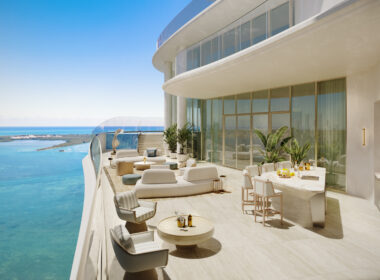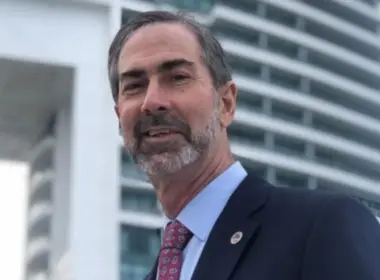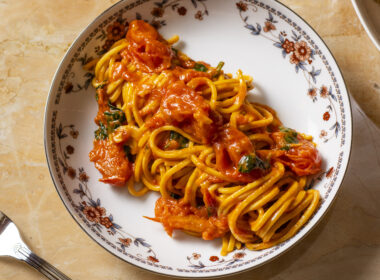At the recent Latin American Fashion Summit, South and Central American designers strutted their stuff
By Harriet Mays Powell
Latinos now form the largest racial and ethnic minority in the United States, accounting for nearly 19 percent of its citizens. According to a 2022 report from the Latino Donor Collaborative, if that population were a country, it would have a GDP of $2.8 trillion, roughly equivalent to that of either the UK, France, or India.

This economic power – let alone the buying power in Latin America itself – has not gone unnoticed by two fashion industry entrepreneurs, sisters-in-law Estefania Lacayo and Samantha Tams, who together founded the Latin American Fashion Summit (LAFS) in 2018. Their mission was to bring Latin American talent to the global fashion industry. After a successful fourth summit held in the Miami Design District last November, where the event will now be an annual fixture, the duo recently launched their newest venture, “Raíces” or “Roots,” in Santo Domingo, capital of the Dominican Republic.
The three-day, jam-packed event was staged in March, just a week after the end of the Paris fashion shows. Lacayo and Tams invited the fashion industry to the Caribbean, with the aim of creating a fusion between a networking event and a trade show. In contrast to a typical dreary convention center venue, Raíces took over the historic 16th-century Ciudad Colonial, a UNESCO World Heritage Site. Thanks to support from the Dominican Republic’s Ministry of Tourism, as well as various other sponsors, they were able to “show the culture, the heritage, the artisans, and the gastronomy of the host country,” says Tams. “We wanted to expose our guests to the best of Latin America.”
On arrival, it was hard not to be impressed. A private car shuttled me from the airport to a townhouse hotel in the colonial zone, a charming bougainvillea-smothered establishment replete with antique furniture, plunge pools, and private butlers. No detail was left untouched. The opening event, themed “Caribbean Nights,” featured live music, lavish décor, and regional cuisine. Lacayo admitted to me that she is a “fanatic about aesthetics,” and despite the splendor of the setting she continued to mumble her dissatisfaction with the venue’s chandeliers for much of the evening.


On the following days, lunches were hosted in the city’s top restaurants, with cocktail receptions held at museums and art exhibitions. Lacayo, Tams, and most of the attendees were dressed from breakfast to past midnight in a parade of glamorous gowns by a portfolio of Latin designers. Lacayo explained the intended difference between Raíces and the LAFS summit in Miami. “The latter is a think tank of sorts,” she said, “combining C-suite executives and power brokers with celebrity guest speakers like Pharell Williams and the socialite and Moda Operandi founder, Lauren Santo Domingo. [LAFS] is not just to uncover the new fashion coming out of Latin America but the latest in business best practices as well.”
In contrast, the purpose of the Raíces event was to facilitate “more casual interactions between those doing business in Latin America and those looking to do so,” said Lacayo. “Many growing brands aren’t interested in learning about the metaverse from some CEO. They’re just not there yet.”

Raíces will rotate each spring to a different Latin American city. Emerging designers will be able to meet buyers, learn how to pitch magazine editors, and hear what fashion directors from large U.S. retailers want via panel discussions or intimate Q&As. At the March event in Santo Domingo, sessions were housed in the tented courtyard of an historic fortress, Fortaleza Ozama. Participants could meet speakers like designers Esteban Cortazar or Raul Lopez of Luar (a Louis Vuitton Moët Hennessy designer award finalist this year), as well as Karla Martínez de Salas, head of editorial content at Vogue Mexico & Latin America.

In another landmark building nearby, Casa de los Vitrales, two floors were brimming with pop-up booths. There, regional brands exhibited their wares, allowing interaction with buyers and editors, as well as fostering informal meetings between fellow Latinos.
Support for nascent designers comes through scholarships provided by NGOs, wealthy individuals, and marquee brands that include Tiffany & Co, Michael Kors, Audemars Piguet, and Lexus. Lacayo stresses, however, the importance of limiting scholarship funding. “Don’t give them 100 percent,” she says. “Let them be a little hungry. If they don’t have any skin in the game, then they don’t learn from their mistakes.”
The duo’s own paths to success were not initially paved with gold. Tam described to me the misogyny she experienced when expecting her second child while working as a buyer at Saks Fifth Avenue in Mexico. Initially, she had no thought to become an entrepreneur but decided she didn’t want to be part of the corporate system.

Lacayo, on the other hand, had a falling out with her then-business partner in a New York fashion start-up, which had left her “feeling like a complete failure.” She stopped work for a year to concentrate on beginning a family, which eluded her given the stress. Along the way, her husband (who she says is a huge feminist) invited her to join him for the Ideas Festival at the Aspen Institute where she listened to the likes of Warren Buffett and Jeff Bezos. This provided her with the “aha” moment. Calls to fashion directors and friends in the industry resulted in positive feedback about her vision. She then returned to her hometown in Nicaragua for a family vacation that included Tams. There, the two decided to join forces and agreed to imbue their new company with the “core values of sustainability and social impact, with a primary aim of giving upcoming talent access to industry leaders,” says Lacayo.
For myself as a fashion journalist, with much of my career spent in New York and the European fashion capitals, it was fascinating to witness the array of talent on display in Santo Domingo. A steady stream of designers continues to emerge from Colombia, with Emma Carvajal’s line of handbags, Michu, winning deserved praise from buyers and editors alike for sophisticated designs using sustainable materials that support regional artisans. Another Colombian brand, Oculta, produces one-size garments, also made from sustainable materials, which are inspired by indigenous people in Africa.




A leading Peruvian brand, Escudo, showed their superb designs of crocheted dresses that take a month to make, one of which was worn by Czech supermodel Karolina Kurkova – who flew in directly from the Oscars – at the final night’s dinner. Rounding out the highlights were Nicaraguan jeweler Georgina Vargas’ line, Geo, comprising modern interchangeable vermeil pieces made from recycled silver. I also loved the authentic Panama straw hats, hand-woven in Ecuador and produced by the ‘lawyers turned hat designers’ duo behind the firm Modern Monarchie. A special edition, decorated with gold-plated pins with semi-precious stones, was designed exclusively for the guests at the lunch they hosted during the event.
But apart from Alexandre Birman, a leading shoe designer and a sponsor of LAFS, there were surprisingly few contributors from Brazil. Lacayo admits that they haven’t yet cracked Brazil. “It’s like a bubble in its own right, but we’ll get there!” she told me.

Each succeeding LAFS summit has doubled its attendance. According to company research, some 45 percent of participants are Latinos living in Florida, New York, California, and Texas. Another 40 percent come from Latin America, while the remaining 15 percent are from Europe, Asia, and Africa. At the time of writing, final numbers weren’t available from the inaugural Raíces event. But if the last LAFS numbers are any indication – 2,200 combined virtual and live attendees, 80,000-plus social media followers, and 494 million impressions across influencer accounts, shared content, and press – their audience continues to grow. And in addition to their two annual live and virtual summits, Tams and Lacayo have launched Tribu, a subscription-based tech platform intended to connect fashion entrepreneurs via a social media app.
Unsurprisingly, several Latin American countries have already lobbied to be the next locale for Raíces 2024.












